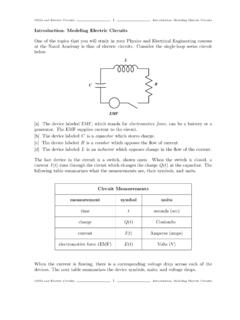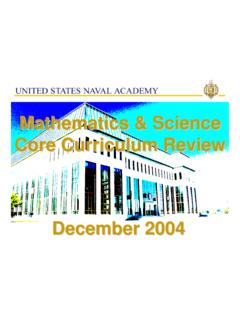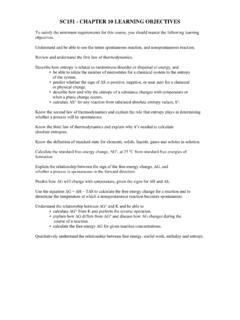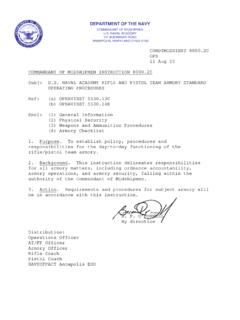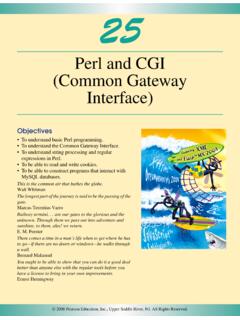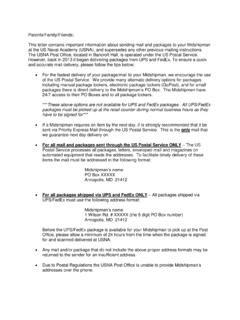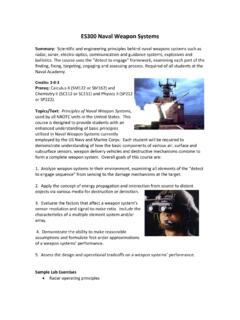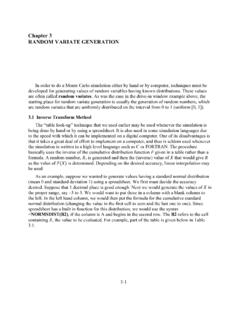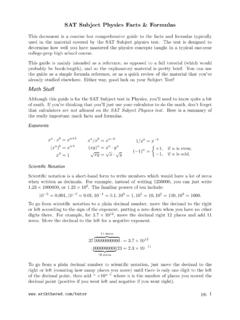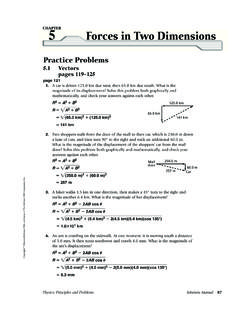Transcription of GRE PHYSICS STUDY GUIDE - USNA
1 GRE PHYSICS STUDY GUIDE by the Department of PHYSICS and Astronomy Trinity University 1 2 The GRE PHYSICS Structure of the How the Exam is Performance Preparation and Test-Taking 3 Subject Classical The Circular Rotational The Electric Forces and Magnetic Forces and Maxwell s RLC Optics and Wave Ray Mirror/Lens 20 Thermodynamics and Statistical Compressions and Boltzmann Other Useful Quantum The Probability and Operators and Expectation Atomic Electron The Bohr Special Length Contraction and Time Miscellaneous Watch Your Units!..27 Particle Nuclear 4 Practice The 5 You re Not Done!..40 21 Introduction If you are considering applying to graduate school in PHYSICS , you are going to have to take the GRE PHYSICS subject exam.
2 You will find that this exam is different than any other PHYSICS test you have taken in a number of ways. Some of these ways will be obvious: the test covers everything you have learned in your undergraduate PHYSICS education, and yet is multiple choice and does not require lengthy integrals or other complicated mathematics. Other differences will be more subtle. The purpose of this document is to help you better understand the exam, so that you can wisely spend your STUDY and preparation time. Chapter 2 will familiarize you with the format of the exam, set a performance goal, and describe test-taking strategies you will need to meet that goal. Chapter 3 (the bulk of this document) will give some fundamental physical principles that nearly always appear on the exam, as well as example problems for each subject. Chapter 4 will include a mini-exam that concentrates on the PHYSICS covered in Chapter 3.
3 2 The GRE PHYSICS Exam Structure of the Exam The GRE PHYSICS exam consists of 100 questions with a time limit of 170 minutes (2 hours 50 minutes), or just under two minutes per question. Each question is multiple-choice with five answer options given. According to the Educational Testing Service, the typical exam will cover the following subject matter (the percentages indicate on average how many questions address each subject): 20% - Classical Mechanics (such as kinematics, Newton s laws, work and energy, oscillatory motion, rotational motion about a fixed axis, dynamics of systems of particles, central forces and celestial mechanics, three-dimensional particle dynamics, Lagrangian and Hamiltonian formalism, noninertial reference frames, elementary topics in fluid dynamics) 18% - Electromagnetism (such as electrostatics, currents and DC circuits, magnetic fields in free space, Lorentz force, induction, Maxwell s equations and their applications, electromagnetic waves, AC circuits, magnetic and electric fields in matter) 9% - Optics and Wave Phenomena (such as wave properties, superposition, interference, diffraction, geometrical optics, polarization, Doppler effect)
4 10% - Thermodynamics and Statistical Mechanics (such as the laws of thermodynamics, thermodynamic processes, equations of state, ideal gases, kinetic theory, ensembles, statistical concepts and calculation of thermodynamic quantities, thermal expansion and heat transfer) 12% - Quantum Mechanics (such as fundamental concepts, solutions of the Schr dinger equation (including square wells, harmonic oscillators, and hydrogenic atoms), spin, angular momentum, wave function symmetry, elementary perturbation theory) 10% - Atomic PHYSICS (such as properties of electrons, Bohr model, energy quantization, atomic structure, atomic spectra, selection rules, black-body radiation, x-rays, atoms in electric and magnetic fields) 6% - Special Relativity (such as introductory concepts, time dilation, length contraction, simultaneity, energy and momentum, four-vectors and Lorentz transformation, velocity addition) 6% - Laboratory Methods (such as data and error analysis, electronics, instrumentation, radiation detection, counting statistics, interaction of charged particles with matter, lasers and optical interferometers, dimensional analysis, fundamental applications of probability and statistics) 3 9% - Specialized Topics (Nuclear and Particle PHYSICS ( , nuclear properties, radioactive decay, fission and fusion, reactions, fundamental properties of elementary particles), Condensed Matter ( , crystal structure, x-ray diffraction, thermal properties, electron theory of metals, semiconductors, superconductors), Miscellaneous ( , astrophysics, mathematical methods, computer applications))
5 The exam is cleverly written. Many of the questions require more than just recalling which equation is applicable and plugging in numbers, but instead test your physical intuition. My favorite example is the following: m 1. A block of mass m slides with constant velocity v down an v inclined plane with height h and coefficient of friction . By the time the block reaches the bottom of the plane, how much energy h has been dissipated as heat? a. mv2/2 b. mv2/2 c. mgh d. mgh e. mgh/2 At first glance, your instinct may be to recall the formulae you usually apply when given a coefficient of friction, F = N = mg cos ..but you are given neither an angle nor the length of the ramp, so you have reached a dead end. Instead, think of the problem this way you are being asked for an energy, so let us first apply conservation of energy.
6 Since the block is sliding with a constant velocity, the kinetic energy is not changing from the top to the bottom of the ramp. Only the potential energy is changing, and since it is not being transformed into kinetic energy, it must all be dissipated as heat. Thus the amount of energy released as heat equals the change in gravitational potential energy mgh, so the answer is (c). Scoring of the exam is done in a couple of steps. First, you are credited one point for each correct answer, zero points for each omitted question (no answer chosen), and minus one-quarter point for each incorrect answer. This is called your raw score. So for example, if you answered 64 of the 100 questions, and answered 48 correctly and 16 incorrectly, your raw score would be 48 (16/4) = 44. Next, the raw score is converted to a scaled score, much like the SAT exam, though in this case the scores range from a high of 990 to a low of about 400.
7 The conversion is applied to cancel out the difficulty level of a particular exam, by requiring that a certain number of examinees score a 990, a few more get 980, and so on. This allows scores to be comparable from one exam to the next. Table 1 (again taken from the ETS website) shows which scaled scores corresponded to which raw scores for each of three different exams. Raw Scores Scaled Score Test A Test B Test C 900 73 68-69 64 800 58-59 54-55 50 700 44 41 38 600 30 27 27 Table 1: Raw scores needed to achieve certain scaled scores on three GRE PHYSICS exams When you receive your scores, you will see your raw score, your scaled score, and a percentile.
8 This is the percentage of examinees whose scores you exceeded. Table 2 shows the raw and scaled scores associated with several percentiles for a practice exam on the ETS website. 4 The most important lesson to draw from these tables is that the GRE PHYSICS exam is tough! Only a small number of examinees will exceed even 60% correct. So you should not prepare for the exam by trying to relearn everything, with the expectation of answering most of the questions correctly. We ll talk more about how this will affect your STUDY plan later in this chapter. Percentile Scaled Score Raw Score 99 990 85 90 900 73 80 820 61 70 760 53 60 710 45 50 660 38 40 620 33 30 580 27 20 530 20 10 480 13 Table 2.
9 Raw and scaled scores for certain percentiles on sample GRE PHYSICS exam How the Exam is Used It would be impossible to make a blanket statement about how every graduate school uses the GRE subject exam score in their evaluation of applications. Different schools will weight the exam differently in their decision-making process, and will have a different definition of high and low scores. Having said that, the following is true for many graduate schools. Admissions boards look primarily at undergraduate grades (particularly in upper-level PHYSICS courses), recommendations, and any research experience (always a big plus). The GRE score is typically used as a check, a verification that the student has learned the material that the undergraduate transcript says (s)he has been exposed to. It has the advantage of being calibrated nationwide, unlike grades, which may represent a widely different level of accomplishment from one school to the next.
10 An average or better GRE score raises no eyebrows. A low score, however, is a red flag to admissions officials that the transcript may not be telling the whole story. Performance Goal Given what you have learned about the subject exam, what are you trying to accomplish? Your goal should be to score well enough to avoid drawing attention away from your strong transcript and research background. So what score should you be trying to achieve? Notice in Table 2 that the scores are most crowded together around the 30th-50th percentile ( , the difference in scores from one line to the next is the smallest). This corresponds to scaled scores in the low 600 s and raw scores in the low 30 s. So let us say that your performance goal is a scaled score of 600. This will put you ahead of at least one-third of examinees, and lumped in with a large crowd of similar scores.
